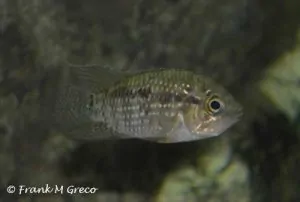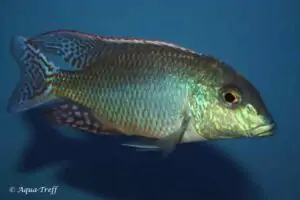Thorichthys pasionis
Thorichthys pasionis is also called the “Yellow Meeki”. And with the latter he shows many similarities. It is all the more remarkable that Thorichthys pasionis is always found together with Thorichthys meeki. There is, however, one exception to that. In Lake Peten, T. pasionis is not accompanied by T. meeki but by Thorichthys affinis. (another argument for merging meeki and affinis). Why T. meeki and T. pasionis do not hybridize is a complete mystery. All the more so because in addition to the habitat, they also seem to share the niche.
Juan Artigas has kept T. pasionis together with T. meeki for years and has not identified any differences in food and foraging habits. Thorichthyssen hybridizes effortlessly in an aquarium. So watch out. Thorichthys pasionis has black gill membranes. This contrasts with those of T. meeki, which are strikingly red. There is one exception to this, and again Lake Peten is the crime scene ;) Recent catches by John Heaton (an enthusiast who lives at the lake) show that part of the population has red gill membranes. Would this point to natural hybridization (with T. affinis)? John has also caught fish without the black gill cover spots so characteristic of Thorichthys. Much is still unclear about the fish populations in Lake Peten. There are even rumors that the near-legendary “margaritifer” still swims in the lake. A taxonomic study of the Lake Peten community would be highly desirable.
Thorichthys pasionis is the largest Thorichthys. Males can easily reach 17 centimeters. Females stay noticeably smaller.
Etymology
Pasionis refers to the river in which the type specimen was caught “Rio de la Pasión”. Synonym: Cichlasoma pasionis.
Origin
Mexico, Guatemala.
Distribution
Rio de la Pasión (where the type specimen came from) is also the southernmost part of its distribution area. From here, its acreage extends further north, in rivers that flow into the Gulf of Mexico. From the Grijalva in the West to the Candelaria in the East. Here it prefers to inhabit the slow-flowing lower reaches and stagnant residual pools of lakes and lagoons. It does not occur in the North-East of Yucatan and Belize where T. meeki has to do without the company of T. pasionis.
Behavior
I have come to know T. pasionis as the “most peaceful” Thorichthys. Less aggressive than T. meeki. These fish are therefore good to keep in small groups, as they are used to in nature.
Diet
All kinds of insects and especially their larvae. They love red mosquito larvae. In the aquarium, they are also satisfied with dry food that they preferably eat from the bottom.
Breeding
Easy. The eggs are preferably deposited on a vertical surface. Juan Artigas says that his fish like to spawn in flower pots (with the opening upwards). The eggs are deposited one by one a little apart (adaptation to oxygen-poor water).
The Aquarium
A fairly easy to keep cichlid that should preferably be kept in groups from an aquarium size of about 150 centimeters. A soft bottom (fine sand) is a must. Of course they have that long snout for a reason;) Water medium to hard. PH alkaline. Pretty warm. Minimum 25C.
Video
Author
Rene Beerlink – NVC
Copyright images
Alex Penninkhof
Lee Nuttall
Reference
Thorichthys pasionis was discovered/described surprisingly late. There is no clear explanation for this, because its distribution area is relatively large and where it occurs, it is often in considerable numbers. She may have been mistaken for a pale meeki for a long time.
Rivas L.R.1962. Cichlasoma pasionis, a new species of cichlid fish of the Thorichthys group, from the Rio de la Pasion, Guatemala. Historie naturelle des poissons. v. 25 (no. 2): 148-156
Literature
A very nice article about T. pasionis can be found on the internet in “The Cichlid Room” by Juan Artigas. 1995 “The yellow meeki” http://www.cichlidae.com/article.php?id=148

































Reviews
There are no reviews yet.